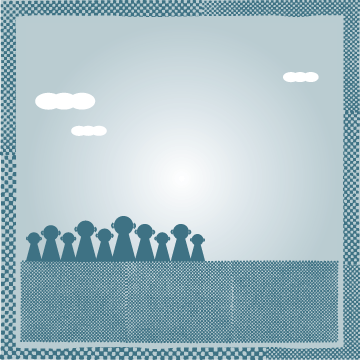I fell in love with architecture on the Chicago River. It provides a beautiful vantage point to take in all the marvelous skyscrapers. Unlike other cities that cram you on the sidewalk between looming towers.
(Engineers take a bucket ride, 1899, from The Lost Panoramas.)
Enter Ellis Chesbrough, an engineer from Boston. (If you’ve never heard of him, you’re not alone. At this writing, he doesn’t have a Wikipedia entry.)
Ellis Chesbrough proposed a sewer system. It looked like this.
(A hotel in Chicago gets raised. Note the hotel guests standing on the balconies, watching their view get better one quarter-inch at a time. Image via WikiMedia Commons)
There’s this great picture from 1857: It shows a massive hotel— big as a city block and at least three or four stories tall— with dozens and dozens of guys cranking away in perfect sync.
This kind of thing happened over and over again, all throughout Chicago. Businesses stayed open while they were getting cranked up. Meanwhile, teams of masons laid bricks for a new foundation at top speed, literally working around the guys with the jackscrews.
Here’s 35 tons worth of of stores and offices—an entire city block—getting hoisted up.
(Image via WikiMedia Commons)
Jacking up the streets and buildings took about 20 years to finish. And by that time, Project Number Two was already done.
(Image from Ellis Chesbrough’s Facebook page. Yes, really.)
(Image from the Linda Hall Library of Science, Engineering and Technology.)
The work literally went on around the clock, from both sides: One crew dug by hand for 16 hours a day. Then a crew of bricklayers took the graveyard shift, shoring up the area that had just been dug out.
(Image from Chesbrough’s Facebook.)
Chesbrough was regarded as a genius, but he still hadn’t really solved the problem. Chicago was still growing like crazy—maybe 200,000 people by 1865—and dumping more waste into the river than ever.
That part of the river’s South Fork still goes by the name it got then: Bubbly Creek. All the discarded animal parts would rot at the bottom of the river and eventually give off methane, which would bubble up to the surface and burst. And sometimes it caught fire.
Meanwhile, the city kept growing. There were half a million people by 1880, which meant even more excrement.
(The caption from this Chicago Daily News photo is “Chicken standing on encrusted sewage.” Can you spot the chicken?)
(From The Story of the Metropolitan Sanitary District of Greater Chicago: The Seventh Wonder of America, published in 1915 by the Metropolitan Sanitary District of Chicago. Digitized by the Internet Archive.)
(From The Story of the Metropolitan Sanitary District of Greater Chicago: The Seventh Wonder of America, published in 1915 by the Metropolitan Sanitary District of Chicago. Digitized by the Internet Archive.)
(From The Story of the Metropolitan Sanitary District of Greater Chicago: The Seventh Wonder of America, published in 1915 by the Metropolitan Sanitary District of Chicago. Digitized by the Internet Archive.)
In 1899, after all the major digging had been done, St. Louis authorized its attorney to prepare a lawsuit, asking the U.S. Supreme Court for an injunction to stop the Sanitary District of Chicago from opening up the dams and letting the water go.
But a lawsuit can takes months to get ready. Chicago sped up construction to get the dams ready to open before St. Louis can get an injunction.
On January 2, 1900, the Sanitary District of Chicago trustees snuck out at dawn to meet on the city’s Southwest Side and dig open a cut that sent the river water flowing into the canal.
Two weeks later, on January 17, 1900, they take another early-morning trek, to lower a dam at Beaver Creek, releasing the water and sending it south towards the Mississippi
The canal and river reversal was later called a “Civil Engineering Monument of the Millennium” it was a functional monument to our dominion over the natural world. Or, so we thought.



























 Our lives are filled with loops that hurt us, heal us, make us laugh, and, sometimes, leave us wanting more. This hour, Radiolab investigates the strange things that emerge when something happens, then happens again, and again, and again, and again, and again, and … well, again.
Our lives are filled with loops that hurt us, heal us, make us laugh, and, sometimes, leave us wanting more. This hour, Radiolab investigates the strange things that emerge when something happens, then happens again, and again, and again, and again, and again, and … well, again.

 To what extent is color a physical thing in the physical world, and to what extent is it created in our minds? We start with Sir Isaac Newton, who was so eager to solve this very mystery, he stuck a knife in his eye to pinpoint the answer. Then, we meet a sea creature who sees a rainbow way beyond anything humans can experience. And we end with an age-old question, that, it turns out, never even occurred to most humans until very recently: why is the sky blue?
To what extent is color a physical thing in the physical world, and to what extent is it created in our minds? We start with Sir Isaac Newton, who was so eager to solve this very mystery, he stuck a knife in his eye to pinpoint the answer. Then, we meet a sea creature who sees a rainbow way beyond anything humans can experience. And we end with an age-old question, that, it turns out, never even occurred to most humans until very recently: why is the sky blue?
